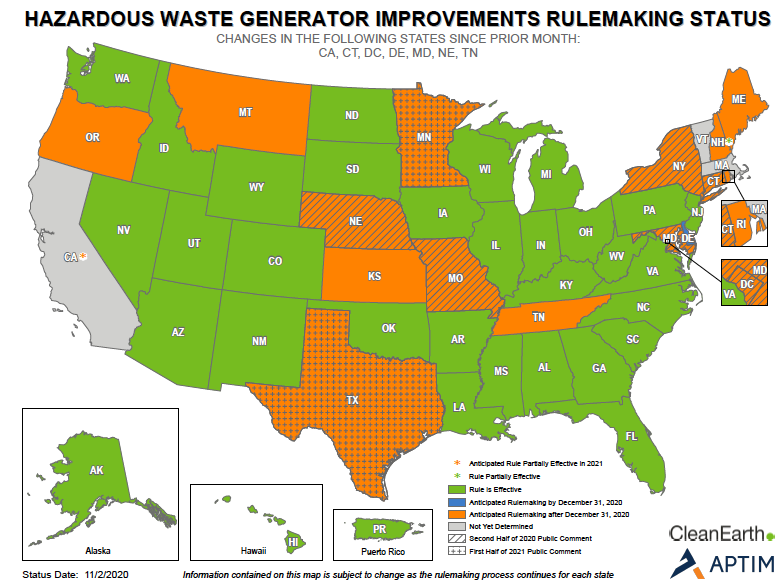Haz Waste Generator Improvements Rule State Adoption Progress
NOVEMBER 16, 2020
The Environmental Protection Agency’s (EPA) Hazardous Waste Generator Improvements Rule (HWGIR) provides a needed update to the hazardous waste generator regulations with the goal of simplifying hazardous waste management by allowing greater flexibility for how entities dispose of hazardous waste.
The rule is now in effect in 32 states and the U.S. territory of Puerto Rico. 16 states are currently in the rulemaking process, while three others are pending adoption.
As more states continue working toward adopting the Final Rule in order to reach compliance, Clean Earth is tracking implementation and timelines for public comment.
California’s rulemaking timeline has not yet been determined; however, the rule is expected to be partially effective in 2021. Delaware is anticipated to have rulemaking by Dec. 31, 2020.
In addition, rulemaking after Dec. 31, 2020, with public comment in the second half of 2020, is likely in:
- Connecticut
- Washington, D.C.
- Maryland
- Nebraska
- Tennessee (no public comment period determined)
Based on information from states, adoption of the HWGIR will continue to occur into 2021 and may even extend into 2022.
Important to note: The HWGIR finalized a requirement for all small quantity generators (SQGs) of hazardous waste to re-notify the EPA of their hazardous waste activities every four years. The purpose of the re-notification requirement is to improve the SQG universe data and maintain more accurate data into the future for outreach, compliance assistance and oversight activities. The first re-notification for SQGs is due by Sept. 1, 2021, and then every four years thereafter. Re-notification for Large Quantity Generators (LQGs) is due by March 1, 2022.
To maintain regulatory compliance, hazardous waste generators should focus on:
- Revising policies and procedures, including
• Waste determination,
• Generator status/category determination and resulting regulatory requirements,
• Manifesting,
• Recordkeeping and reporting, and
• Training.
- Making adjustments at the store or facility level, including identifying hazardous waste accumulation areas and ensuring proper labeling.
- Preparing notifications to agencies to meet new requirement.
Learn more about our Clean Earth’s portfolio of environmentally responsible, flexible and cost-effective offerings to help customers with any hazardous waste management need here.

